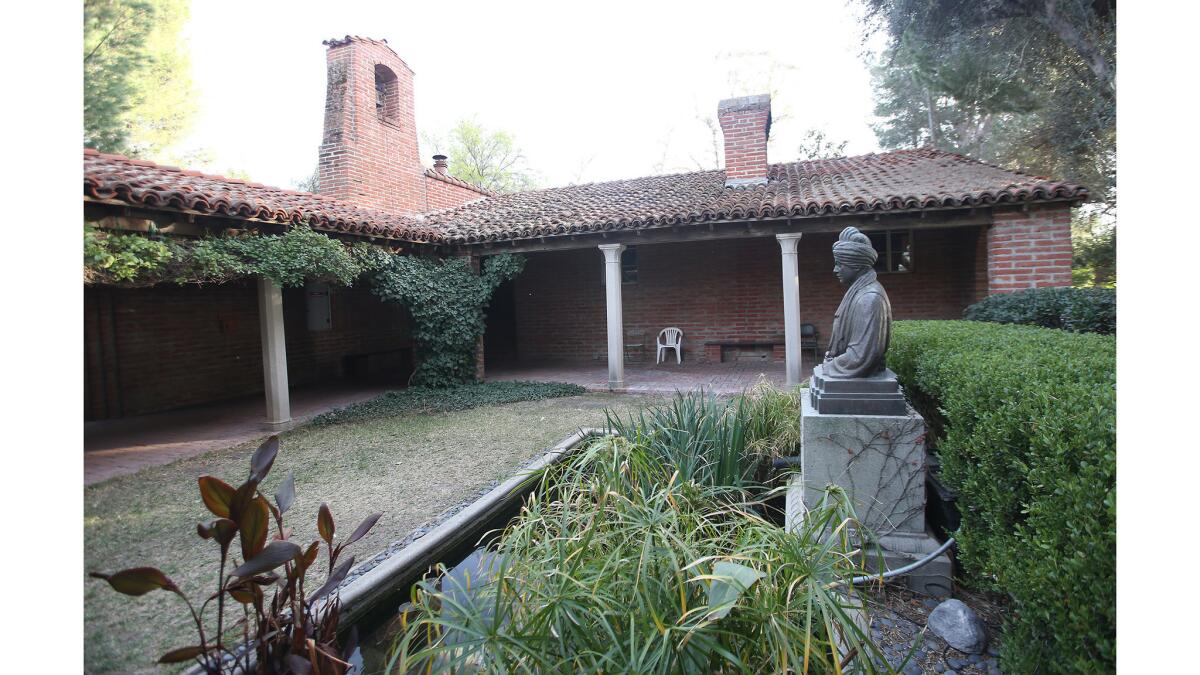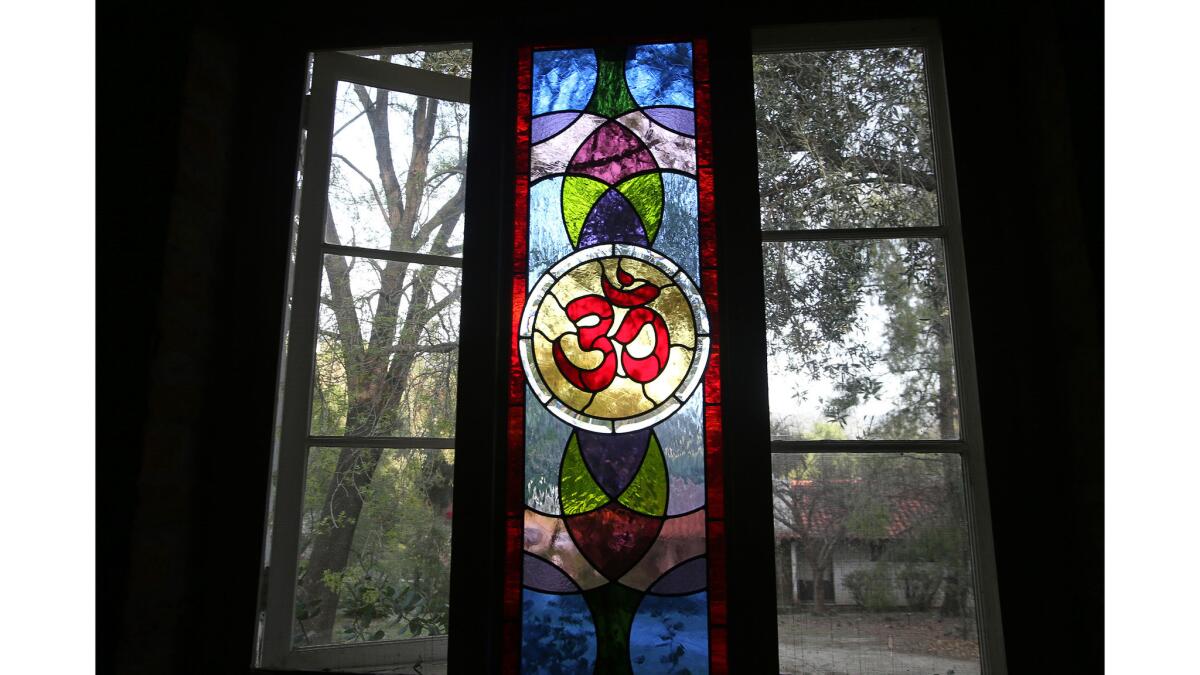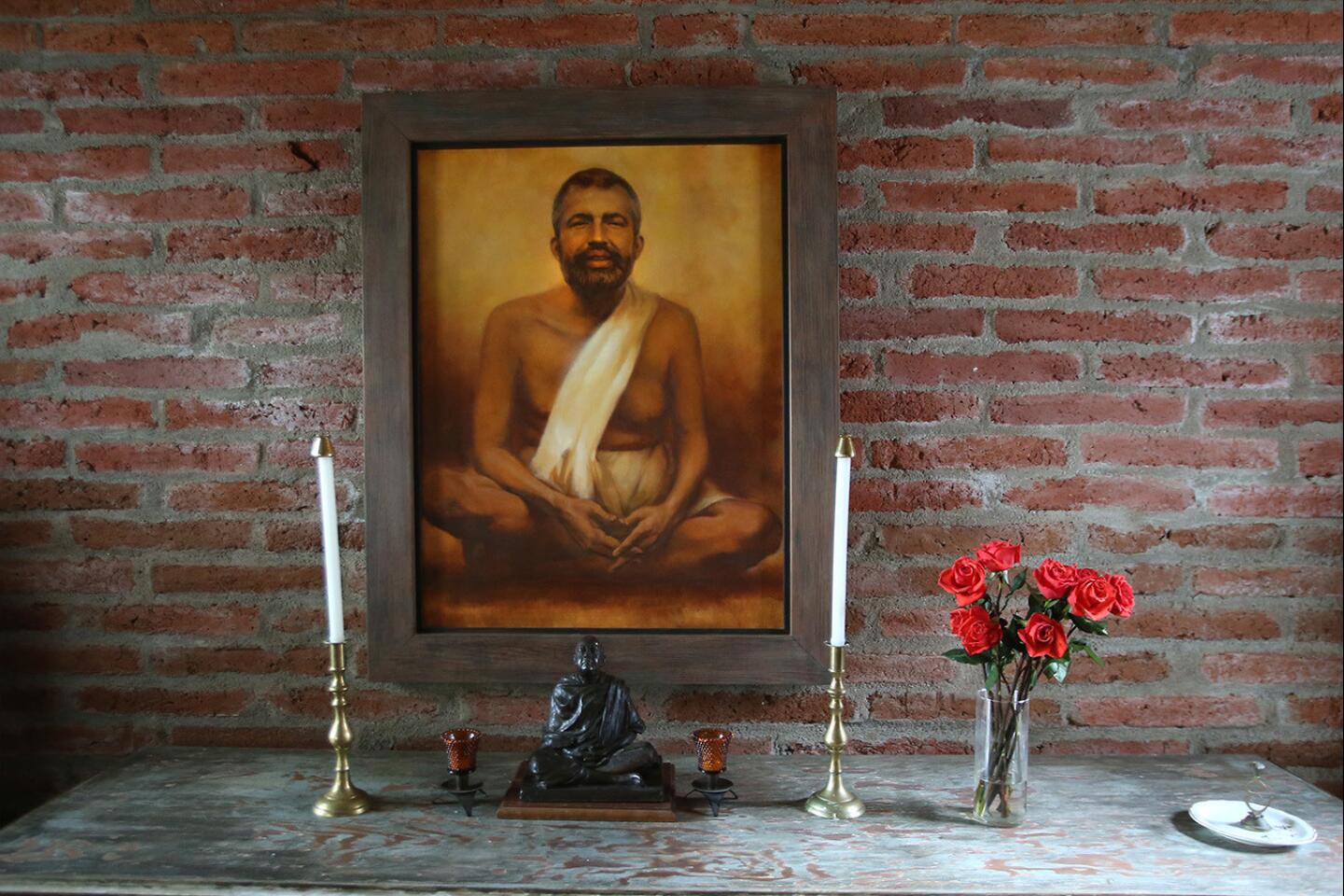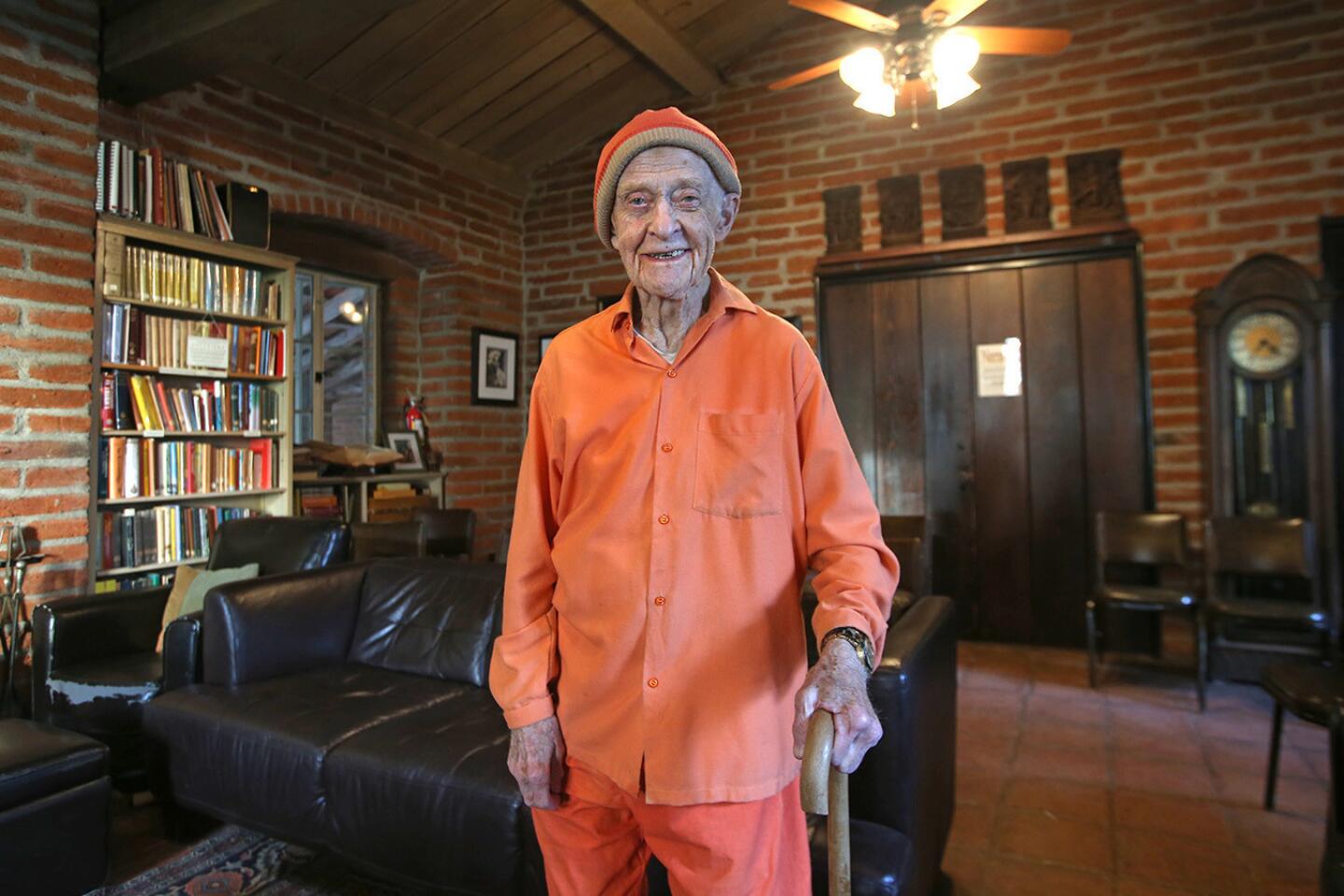The monastery amid O.C.’s mania
- Share via
Past the recalcitrant bikers of Cook’s Corner and up the slithering dirt roads of Trabuco Canyon sits a monastery where monks live in communion with the old ways.
By morning’s waking light, they settle in front of their ancient teacher’s shrine for meditation. They walk the grounds dressed in orange robes. They reject most of the ways of modernity, living as ascetics.
All the while, the Trabuco Canyon Monastery peers out over the rapidly expanding economies of Orange County.
This monastery, which has been at the location in some form since the early 1940s, houses three monks: Swami Dhyanayogananda, 45, Swami Parameshananda, 59, and Swami Yogeshananda, 95. Swami means “religious teacher.”
The monastery is somewhat isolated by a circuitous uphill dirt road. Signs warning drivers to signal their presence with a honk presage two bends in the narrow pass, which is wide enough for about one and a half cars. It’s important to make the ascent slowly.
The monastic grounds, near the north end of O’Neill Regional Park, are embedded in the natural terrain of the canyon. The air is empty — there are few sounds.
Though these are considered sacred grounds by swamis, the public has been allowed to walk them for decades. Hundreds of visitors make this pilgrimage each week, with many sitting in on lectures and scriptural readings.
Amid a landscape of consumerism and mega churches, swamis are hoping to contribute to the spiritual well-being of the county’s residents. Yet, a monastery atop a hill preaching patience, concentration and temperance can only have so much effect in such a manically-paced community.

The Trabuco Canyon Monastery has a varied past.
It didn’t start as a monastery at all, but was regarded as the Trabuco College of Prayer during its infancy.
The college was erected in 1942 by Gerald Heard, an English Renaissance man who was eventually called the “grandfather” of the New Age movement, which was a spiritual development in the 1970s influenced by the counterculture revolution of the previous decade.
Heard developed the college after becoming familiar with a school of Hinduism called Vedanta. Being entrenched in the literary culture of the time, Heard recruited help from his friends and famed authors Aldous Huxley and Christopher Isherwood.
They modeled the monastery within the Italian architectural vein, with red-bricked buildings and a bell tower.
Swami Yogeshananda remembered feeling underwhelmed while visiting the college in 1945.
“Gerald Heard was a brilliant thinker and writer but he had started to try and teach people before he was mature enough,” Swami Yogeshananda said.
In 1947, the college closed due to financial issues and declining interest. Two years later, Heard gave the property to the Vedanta Society, which currently runs the monastery.
The buildings have remained pretty much as they were over the decades, but what has changed is the particular monks assigned to live in and maintain the sacred place.
Swami Yogeshananda has lived as a “retired” monk at the monastery since 2009, though he regularly teaches classes and engages in the spiritual traditions he’s practiced throughout his 70 years as a monk.
The old swami’s spiritual path began while he was working as a warden at a Pennsylvania school for the mentally deficient, a part of his service as a conscientious objector during World War II. While embroiled in what he called “the worst year of his life,” the swami met a monk who began to teach him the spiritual practices that he would come to use for seven decades.
Swami Yogeshananda was receptive because he’d been craving a more methodical spiritualism than was provided by his Quakerism.
“Quakers do a little meditation on Sunday morning, but I realized that it wasn’t anywhere near enough for me,” he said. “I was in search of God, deeply so.”
Because monks live a somewhat nomadic lifestyle, traveling to whichever hermitage they are hailed by spiritual leaders, the swami has been around the world, including China, England and India, which is considered the holy birthplace of Hinduism.
“Join the monastery and see the world,” he said with a chuckle.
In many ways, Swami Dhyanayogananda, the manager of the monastery, came to monkhood for similar reasons.
Born in Buenos Aires, Argentina, he wrestled with the deep spiritual questions that most contend with: Who am I? What is this all about?
Only for him, these questions, from which most can be easily distracted, were like phantoms always grasping at his attention.
The swami was raised Catholic but found Indian culture and mysticism to be engrossing, so when he discovered a Ramakrishna ashram, or monastic community, in Buenos Aires at age 19, his spiritual journey began.
“I was a regular guy then,” he said. “I was in college, majoring in accounting. I never thought I would be a monk, it wasn’t really in my plans.”
But nine years later he was asked to stay in the ashram. He’s been a monk for 17 years, in which he’s spent time in monasteries in San Francisco and India.
He’s been at the Trabuco Canyon Monastery for about two years.

The monks’ lives are humble.
They rise when the morning bell sounds at 6 a.m. and begin meditation. The rest of the day is spent with further worship, taking care of the monastery and sharing meals in between.
“It’s a very simple life, it’s pure,” Swami Dhyanayogananda said. “Our life is the monastery.”
Meditation is the great spiritual tool for these monks. Each considers it the primary method of “bathing” their souls each day.
“Meditation, if it’s done properly, leads to very deep experiences,” Swami Yogeshananda said. “You discover your own soul. Most of us don’t know our own souls.”
Swami Dhyanayogananda meditates for about an hour and a half during the early morning hours at the foot of a shrine of Sri Ramakrishna, the founder of the Ramakrishna Order of India of which the monastery is a branch.
“You become what you meditate on,” he said. “If you are going to meditate on something it should be on that with the highest meaning, usually our idea of God. Then, you become the highest.”
But, these monks are dissimilar from the traditional ones that are bound to their havens, segregated from the general public only to engage with bettering the self. These swamis hope to impart knowledge onto others.
For a few decades, the monastery has allowed the public to roam the grounds and attend scripture readings and lectures. The monastery only has a few rules, including restricting cell phone use and “respecting the silence.”
“We don’t just want to live the wandering life,” Swami Dhyanayogananda said, referring to the ways of ancient mendicant monks. “The idea is to give something in return.”
The swami said a few hundred walk the monastery a week, thirsty for a different kind of spirituality than that provided by Orange County’s other religious institutions.
Yet, with mega churches like Mariners and Saddleback peddling a kind of mass-produced spiritualism, the humble monks stand as Davids to their Goliath.
The monks are welcoming of all religious faiths. Rather than seeking to impart a religious ideology on visitors, they hope to impress upon people spiritual practices that can be used in any religion. The pursuit of these practices is to have spiritualism become a part of one’s daily life, rather than relinquishing one’s days to the material world except for an hour on Sundays.
The swamis contend that maintaining a spiritual daily regimen takes concentration and dedication, characteristics that can be difficult to cultivate amid the hustle of the day.
“People come here and listen to our talks and lectures and say this is what they have been looking for,” Swami Dhyanayogananda said. “That we have a purpose and not to live a mechanical life. Our life is full of meaning and we should awake to that.
“We have to be coherent. What we speak should be translated in our actions.”
The leading religious institutions of the county tend to offer a more convenient spiritual method — one that demands less of its consumer.
“Everyone has the potential to be a spiritual aspirer,” Swami Yogeshananda said. “But, it’s completely buried by modern habits and encouragements. Nobody has any idea anymore how to get there.”

During a recent scriptural session, Swami Yogeshananda read aloud from a book he has been studying all his life. His weathered hands, with vectors of ligaments and tendons protruding from underneath the thin skin, slowly trace across the page.
To his back, flames within a fireplace sent sparks up through the throat of the chimney.
Sadhu, the monasterial dog, slept in his bed outside the door, rigidly monastic in the adherence to his own traditions. Aged books with flaking covers lined the walls and a grandfather clock’s pendulum swayed in union with time.
About 30 people gathered in the monastery’s intimate library, seated in foldable chairs and splayed out on leather couches, their eyes fixed on the religious master.
In finishing his scriptural reading, the old swami told the room that the world is experiencing a decline in spirituality — a symptom of the increasingly material-focused world. Even in India, the sacred place.
“But here’s the book,” Swami Yogeshananda said, placing his hand firmly on its cover. “The book will remain. You can always read it.”
Twitter:@benbrazilpilot
All the latest on Orange County from Orange County.
Get our free TimesOC newsletter.
You may occasionally receive promotional content from the Daily Pilot.

















